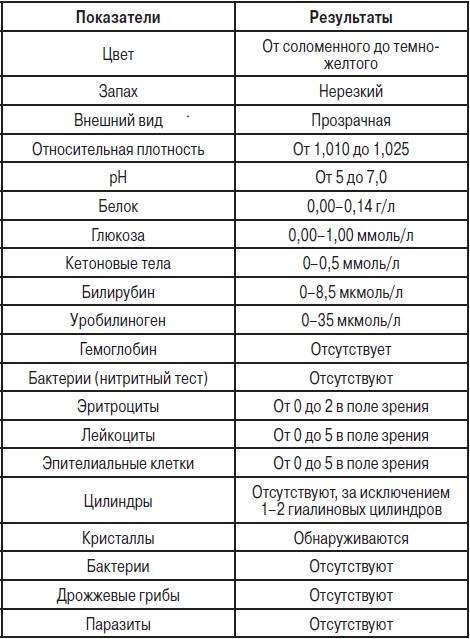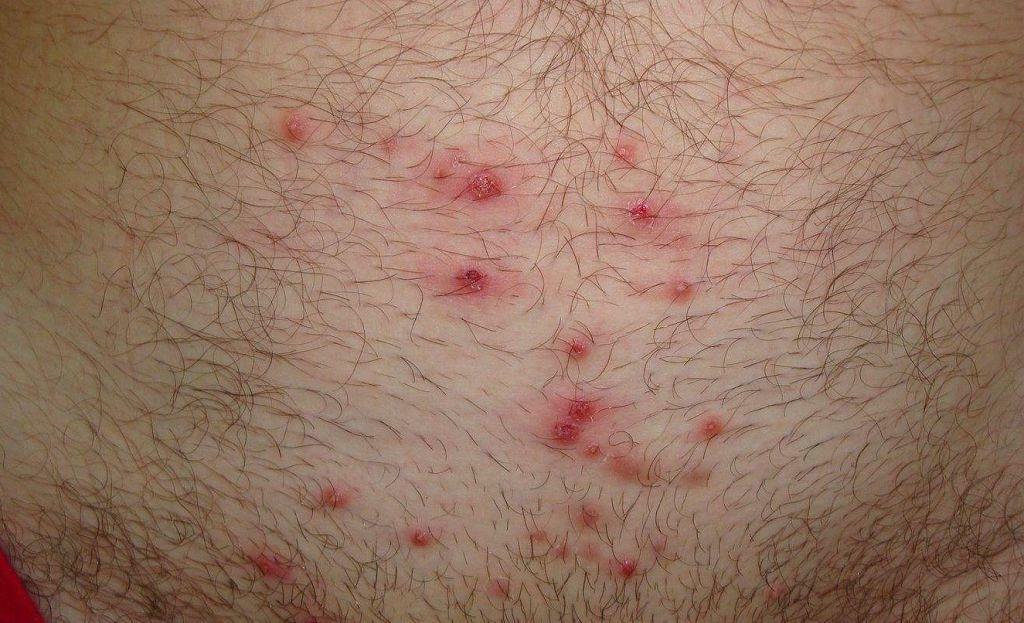Borreliosis is an infectionthat enters the body with a tick bite. But there are other methods of infection. Additional names for the disease are Lyme disease, Lymeborreliosis.
The causative agent of the infection is a spirochete of the genus Borrelia. When a disease occurs, drug treatment should be studied to reduce the likelihood of complications. Otherwise, the infection can affect the entire body.
Record content:
- 1 What is tick-borne borreliosis, description of the pathogen
- 2 How Lyme disease develops, causes of infection
-
3 Symptoms
- 3.1 Stage 1
- 3.2 Stage 2
- 3.3 Stage 3
- 4 Classification
- 5 Diagnosis of tick-borne borreliosis
-
6 Treatment of tick-borne borreliosis with drugs
- 6.1 Antibacterial therapy
- 6.2 Normalizing intestinal microflora
- 6.3 Detoxification therapy
- 6.4 Symptomatic treatment
- 6.5 General strengthening therapy
- 7 Complications of borreliosis
- 8 Disease video
What is tick-borne borreliosis, description of the pathogen
Lyme disease (treatment and drugs are needed to reduce the likelihood of complications) is a pathology that is transmitted through the ixodid tick. Borreliosis is widespread in Europe, Asia, North America.
In the Russian Federation, 6-8 thousand are found annually. new cases of pathology. In the Russian Federation, the prevalence is uneven. The incidence is noted in 49 subjects, but the highest level is in the Ural, West Siberian and Far Eastern districts.
The name of the disease originated from the place of origin. In 1975. in Lyme, Connecticut, an infection was detected.
The disease can appear at any age. But most often borreliosis occurs in children and adolescents (up to 15 years old). And also the disease occurs in adults aged 25 - 44 years.
In nature, borreliosis is common in the forest-steppe and forest zone. The pathogen circulates between wild animals and ticks. Borrelia settle with the help of migratory birds, that is, they attach to them.
Of the people, urban and rural residents are most often infected. A tick can get on the body when walking through the forest, forest park, garden. Parasites are active in the morning and in the evening. And in rain and heat, the likelihood of infection is reduced.
The peak of the disease is directly related to weather conditions. The bulk of infections occur in the spring and summer. That is, from April to June (inclusive). But the period may shift, it all depends on the weather. The sooner heat builds up, the faster the mites are activated. The second peak of infestation is from August to October.
On the basis of genetic and phenotypic differences, 12 species of microorganisms of the genus Borrelia were identified. Of these, only 3 are most likely to cause Lyme disease.
Namely:
- B.burgdorferi (found in the USA);
- B. garinii and B. afzelii (more common in Russia and Europe).
A specific feature of Borrelia is their persistence ability. That is, the causative agent of the disease can be in the human body for a long time (more than 10 years). Borrelia evade the immune system, as a result, the pathology becomes chronic.
The ixodid tick is a dark brown parasite that has a hard (pinhead-like) body. Outwardly, the pathogen resembles dirt or a crust on an abrasion.
Borrelia are passed from female to offspring. It is possible to combine several types of pathogen in one parasite. Ticks live for 2 years. Only females hibernate, as males die after mating.
How Lyme disease develops, causes of infection
There are different ways of transmission of tick-borne borreliosis.
Namely:
- transmissible (the most common way) - the disease is transmitted by a tick bite or when a person rubs the remains of the parasite into the wound;
- vertical (transplacental) - the pathogen can enter the fetus from the mother;
- alimentary - pathology is transmitted by consuming milk from an infected animal.

The disease is not transmitted from person to person, except in the vertical way. Infection during sexual intercourse is excluded.
The penetration of the causative agent of the disease from mother to child through breast milk is allowed. The probability of infection is minimal - 1%. But if a woman's symptoms of pathology appear brightly, breastfeeding is excluded.
Borrelia can not only move under the skin, but also penetrate into the vessels. Accordingly, their movement into the internal organs is allowed. Borrelia crosses the blood-brain barrier, which protects the blood vessels in the brain.
After the causative agent of the disease has entered the body, an incubation period develops. Its duration is 3 - 30 days. But on average, the first symptoms of the disease appear within 7-14 days. If not treated, Borrelia spreads throughout the body with blood and lymph.
The likelihood of contracting Lyme disease increases among forest dwellers, forestry workers, and hunters. Additionally, Borrelia can enter the body of fishermen and summer residents. And also the likelihood of infection increases if pets are outside, that is, they can bring the tick into the room.
Symptoms
Lyme disease (treatment and medications can reduce the likelihood of complications) is a pathology that is characterized by symptoms.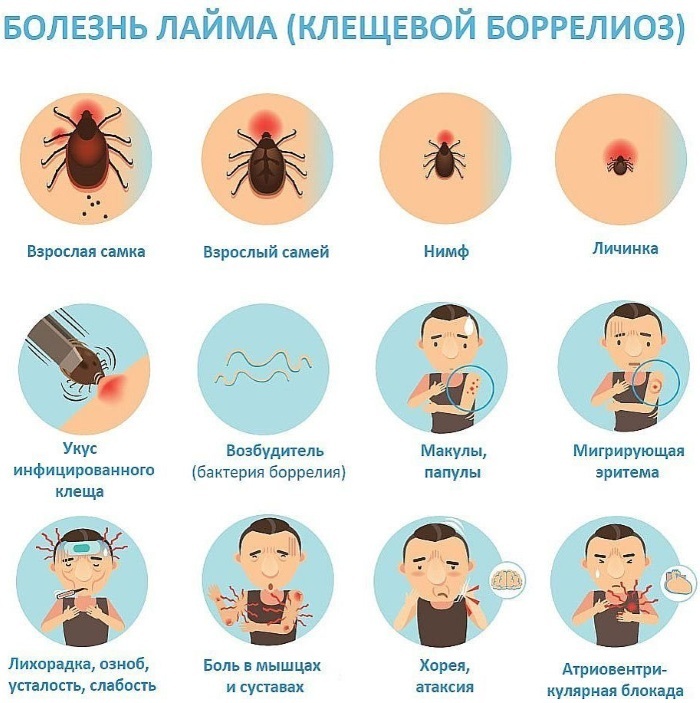
The disease is subdivided into the following stages:
- Localized infection. The stage refers to the early period.
- Disseminated stage. This is the early period. Possibly neurotic, meningeal, cardiac course. And also a febrile, mixed form of the disease is allowed.
- Persistence or chronic stage. This is the late period.
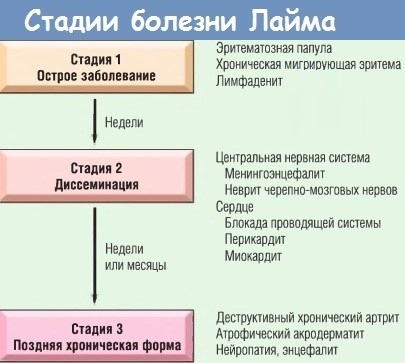
Lyme disease stages
The exact signs depend on the stage of the disease. More information is provided later in the article.
Stage 1
The stage develops after the incubation period. After a person has been bitten by a tick, a red spot appears in this place. The rash grows, called erythema tick-borne migrans. Further, the middle is discolored, that is, a red ring is formed. Its diameter is 10 - 20 cm. The edges of the ring are bright red and the center is pale. The spot may itch and hurt a little.
Most often, erythema disappears after 1 - 2 months. from the onset of the disease, peeling and slight pigmentation (change in normal color) remain on the skin. As the disease progresses, not one ring may appear, but several.
The following symptoms are distinguished as local manifestations:
- increased body temperature together with chills;
- pain in the head, muscles and bones;
- general weakness;
- allergic reaction;
- runny nose;
- nausea and vomiting (rare);
- inflammation (catarrh) of the upper respiratory system is a very rare symptom.
Stage 2
The pathogen spreads through the body with blood flow and lymph. The stage appears after 1 - 3 months. from the onset of the disease.
Damage to the cardiovascular and nervous system often develops. In the first case, myocarditis, cardiomyopathy are isolated. With heart damage, chest pain, shortness of breath, dizziness occur. From the side of the nervous system, the appearance of meningitis, encephalitis is possible.
At this stage, the following symptoms may appear:
- headache of a throbbing character;
- fear of bright light;
- muscle pain;
- increased fatigue;
- deterioration in sleep;
- impaired skin sensitivity;
- hearing impairment;
- lacrimation;
- paralysis.
Conjunctivitis (inflammation of the lining of the eye) can sometimes develop. Hepatitis, sore throat (inflammation of the tonsils in the nasopharynx), nephritis (inflammation of the kidneys) cannot be ruled out.
Stage 3
The disease enters this stage after 6 to 24 months. from the beginning of the infection. Possible memory disorder.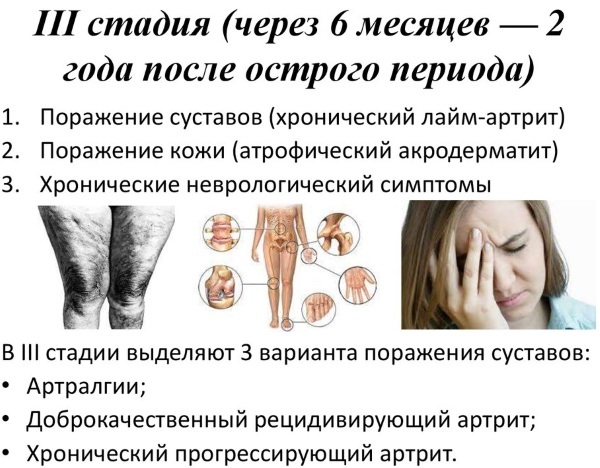
Additionally, the form is characterized by arthritis. In this case, the mobility of the joint is limited, pain occurs. There may be no discomfort, but the knees are swollen. Further behind the joints, cysts form and rupture, which bring pain. In 10% of cases, arthritis lasts more than 6 months.
A characteristic condition for the late form is atrophic acrodermatitis. Edematous erythema gradually forms on the skin. Further, atrophic changes develop. The skin becomes thin, wrinkled. Spider veins are forming.
Additionally, a benign skin lymphocytoma is allowed - this is the formation of red-cyanotic nodes or round plaques. Usually formations appear on the face, ears, armpits. Additionally, it is possible to form knots in the groin. Sometimes the formation turns into malignant lymphoma.
Classification
Lyme disease (treatment and medications are needed to recover) is classified. Details are shown in the table.
| Classification point | Description |
| Flow | Lyme disease can have the following course:
|
| Clinical manifestations | The disease can be of the following types:
|
| Severity | Pathology can be mild, moderate and severe. And also an extremely severe form is allowed. |
| Signs of infection | The disease can be seronegative and seropositive. In the first case, antibodies to borrelia are detected in the diagnosis. Seropositive disease is characterized by the absence of antibodies. |
| Disease form | Borreliosis can be manifest and latent. In the first case, the symptoms of pathology are present. With latent borreliosis, there are no signs, changes in the body can be seen only after diagnosis. |
| Development | The disease is characterized by an early (stage 1 and 2) and late (stage 3) period. |
| Preferential defeat | Lyme disease can predominantly affect a system. For example, nervous, cardiovascular. A combined form of the disease is also allowed. |
Diagnosis of tick-borne borreliosis
If you suspect a disease, you should consult a doctor. Pathology is in the competence of the infectious disease specialist. If it is impossible to contact this specialist, a visit to a therapist is allowed - this is a general practitioner.
Before assigning diagnostics, perform the following points:
- survey - the doctor asks the patient various questions that relate to symptoms and concomitant diseases;
- measurement of important indicators - blood pressure, pulse, temperature;
- examination - a specialist examines the skin of a person.
The doctor can prescribe a referral to an additional specialist, it all depends on the accompanying symptoms. For example, if there is a suspicion of damage to the cardiovascular system, it is recommended to visit a cardiologist.
Lyme disease needs diagnosis. The examination allows you to determine the disease and prescribe medication. Diagnostic methods are shown in the table.
| Diagnostic method name | Description |
| General blood analysis | Using the procedure, you can determine important indicators (erythrocytes, hemoglobin, and more). For analysis, take blood from a vein or from a finger. In private organizations, the first method is used, since it is more accurate. The results will be ready in 1 - 3 days. |
| General urine analysis | The result sheet indicates the color, transparency, odor of urine. Additionally, attention is paid to the density, medium (pH), the number of various indicators (protein, leukocytes, etc.). For analysis, daily urine is used, which was collected in the bladder at night. The results will be ready in 1 - 3 days. |
| Determination of the DNA of the pathogen | For research, take synovial or cerebrospinal fluid. DNA determination method - polymerase chain reaction (PCR). The analysis makes it possible to identify borrelia. Results will be ready in 1 - 3 days. |
| Determination of antibodies | The analysis reveals specific antibodies that indicate a past or current infection. The term for preparing the result is from 1 to 3 days. |
| Tick research | The procedure makes it possible to determine the DNA of the causative agent of the disease. The research period reaches 4 days. |
| Joint X-ray | The diagnostic method makes it possible to determine the condition of the joints. Based on the results of the X-ray, a snapshot of the area under study is obtained. |
| Computed tomography (CT) of the musculoskeletal system | CT is based on X-rays. The procedure is carried out in the following cases:
For the procedure, a person must lie on a couch. It is positioned in such a way that the area under study is in the tomograph. The device is made in the form of a life buoy. A contrast agent may be injected into the human body to improve visibility. With CT, three-dimensional images of the area of interest are obtained. |
| Magnetic resonance imaging (MRI) of the musculoskeletal system | The procedure is based on electromagnetic effects. MRI of the musculoskeletal system is prescribed for the diagnosis of diseases (arthrosis, osteoporosis, etc.). The procedure can be carried out in different ways, it all depends on the device. There is an open and closed device. In the first case, the person lies down on the couch, above which the tomograph is located. That is, you can freely spread your arms and legs, since the space is open. When performing the procedure in a closed tomograph, a person lies down on a couch, she enters the machine. Additionally, they can fix the limbs to avoid accidental movements. To improve visualization, a contrast agent is injected into the human body. MRI makes it possible to obtain three-dimensional images of the area of interest. |
| Electroencephalography (EEG) | Brain research method. With the help of EEG, it is possible to identify pathologies that affect the functionality of the organ. 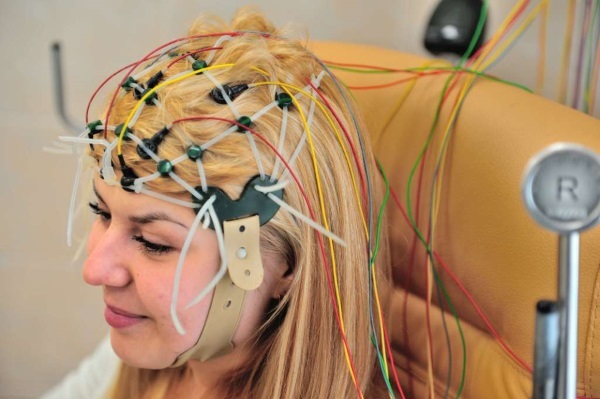 Types of procedure: Types of procedure:
|
| Electrocardiogram (ECG) | The procedure measures the electrical activity of the heart. Biological potentials are recorded using electrodes and displayed on paper or a monitor. The procedure allows you to identify damage to the heart. ECG types:
|
| Abdominal ultrasound | The examination allows you to identify pathologies of the following organs:
The study is carried out by the transabdominal method. That is, a person is asked to take off his clothes to the waist, lie down on the couch. The area under study is lubricated with a gel for better visualization, the sensor is guided over the skin. Ultrasound beams pass through the organ and return to the sensor. The image is displayed on the monitor in real time. |
| Skin biopsy | For analysis, a scraping is made from the skin. Then the biomaterial is sent to the laboratory. With the help of a biopsy, it is possible to determine skin diseases. |
Before undergoing diagnostics, you must follow the preparatory rules. They will be recommended by a specialist.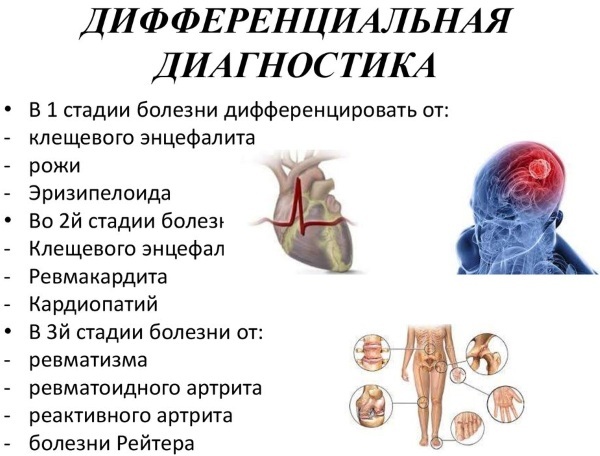
Diagnostic costs may vary. It all depends on the list of procedures, city, organization. Therefore, the exact price must be found out at the clinic.
You can get diagnostics free of charge. To do this, you need to contact the clinic with a compulsory health insurance policy (MHI).
Treatment of tick-borne borreliosis with drugs
Lyme disease (treatment and drugs reduce the likelihood of consequences) requires drug therapy. Medication can help eliminate symptoms and make a person feel better.
For the treatment of the disease, drugs of the following groups are prescribed:
- antibacterial;
- normalizing intestinal microflora;
- detoxification;
- symptomatic;
- fortifying.
All medications are selected by a specialist. The doctor takes into account the stage of the disease, the individual characteristics of the organism. Additionally, they study the instructions for use of each drug.
Antibacterial therapy
Antibiotics kill pathogens. Lyme disease is an infection, so you need to take this group of drugs.
The duration of the use of drugs depends on the stage of the disease.
Namely:
- the first - antibiotics are taken for 10 - 14 days;
- the second - antibacterial agents are prescribed for 2 - 3 weeks;
- third, it is recommended to take antibiotics for at least 28 days.
The approximate duration of treatment is indicated. The specialist can shorten or lengthen the use of antibiotics.
Most often, the following medications are prescribed:
- Sumamed.
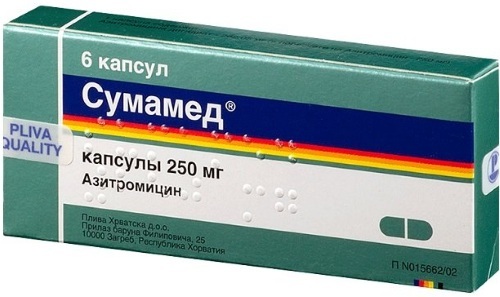
- Amoxiclav.
- Augmentin.
- Ceftriaxone.
- Azithromycin.
- Amosin.
- Flemoxin.
- Tetracycline.
- Doxycycline.
Normalizing intestinal microflora
The drugs normalize the intestinal microflora. This group of medicines is recommended to be taken 3 hours before / after antibiotics. This is necessary to reduce the negative effects of antibacterial agents on the gastrointestinal tract. Additionally, the drugs restore the beneficial microflora of the gastrointestinal tract, which is needed for the digestion and assimilation of food.
Medicines of this group:
- Linex.
- Bifiform.
- Hilak Forte.
- Acipol.
- Bifidumbacterin.
Detoxification therapy
In Lyme disease, endotoxins poison the body. Substances are produced during the vital activity of the infectious agent. To remove endotoxins from the body, enterosorbents are used.
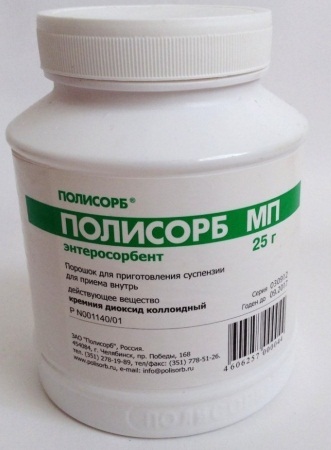
Most often, the following medications are prescribed:
- Polysorb.
- Filtrum-STI.
- Smecta.
- Enterosgel.
- White coal.
- Lactofiltrum.
- Neosmectin.
- Polyphepan.
Symptomatic treatment
Drug therapy is aimed at eliminating symptoms, improving treatment of the disease and avoiding complications. Frequently prescribed drugs are listed in the table.
| Group of funds | Effect of application | List of drugs |
| Non-steroidal anti-inflammatory drugs (NSAIDs) | The drugs lower the temperature, eliminate pain. | NSAIDs include:
|
| Analgesics | Means reduce fever and relieve pain. | Analgin, Baralgin, Took |
| Antiallergic | The drugs eliminate the manifestation of an allergic reaction (itching, urticaria, etc.). | The group includes the following drugs:
|
| Vasoconstrictor | Medicines fight the common cold. | Tizin, Otrivin, Xymelin |
| Antiemetic | The drugs eliminate nausea and vomiting. | Cerucal, Metoclopramide, Motilac |
| Hypnotics | Means improve falling asleep, reduce the number of night awakenings. | Donormil, Melaxen, Melatonin |
| Hepatoprotectors | The drugs restore the structure of the liver, protect the organ from the effects of adverse factors. | Geptral, Phosphogliv, Essentiale Forte N |
| Nootropic | Medication helps to improve memory and blood circulation in the brain. | Piracetam, Nootropil, Glycine |
General strengthening therapy
Lyme disease has a negative effect on the body. The immune system is suppressed, the main function of which is to protect against diseases. In addition, the infection can cause disorder in other organs. To strengthen the immune system, immunostimulating agents are prescribed.
The most common ones are:
- Immunal.
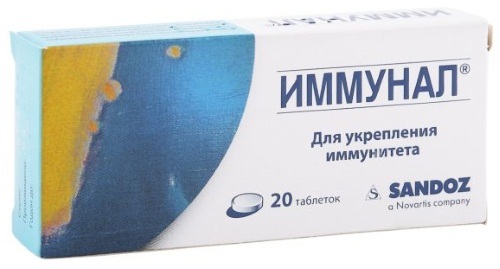
- Immunorm.
- Estifan.
- Echinacea (lozenges).
- Series Doctor Theiss - the manufacturer produces a line of products that strengthen the immune system (with echinacea, calendula and other plants).
- Tincture of Echinacea, Eleutherococcus, Schisandra.
Interferons can be prescribed to strengthen the immune system. The group includes Grippferon, Viferon. In addition, vitamin complexes can be prescribed to strengthen the immune system.
The most common ones are:
- Supradin.
- Complivit.
- Alphabet.
- Centrum.
- Vitrum.
- Multi-tabs.
Complications of borreliosis
The disease is dangerous, as the symptoms can disappear even in the absence of therapy. A person will think that he has recovered or blame everything on a slight malaise. And also symptoms may not appear at all. At this time, a person is a carrier of infection.
Another danger is that if the immune system is weakened, other abnormalities are present, or there is a hereditary predisposition, the symptoms of pathology may be unpredictable. Damage to the nervous or cardiovascular system, musculoskeletal system cannot be ruled out.
And also pathology can affect the brain. All this leads to disability and even death. Most often, complications appear in the absence or untimely treatment of the disease.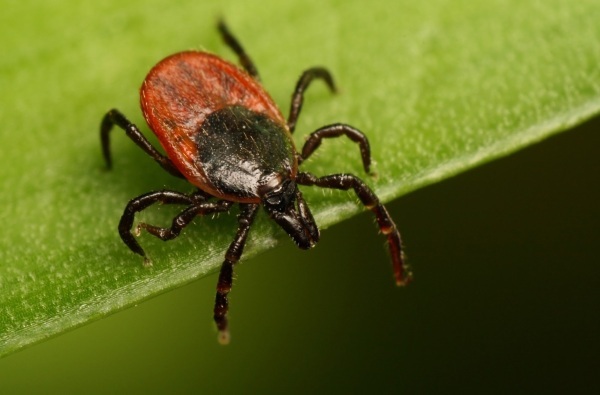
Possible consequences of the disease:
- multiple sclerosis;
- meningitis;
- rheumatoid arthritis;
- miscarriage during pregnancy;
- atrophic acrodermatitis;
- arthritis;
- lymphocytoma;
- disorder of the nervous system, up to dementia;
- loss of hearing and vision;
- a benign tumor on the skin at the site of the tick bite;
- disability;
- death.
Borreliosis is an infection that can enter the body when bitten by a tick. But there are other ways of infection - vertical, alimentary. The disease is called Lyme disease, Lymeborreliosis. Pathology is dangerous, since symptoms can disappear even in the absence of therapy. That is, the person will think that he has recovered.
And also symptoms may not appear at all. Additional hazard - signs can be unpredictable. To make the correct diagnosis, an examination is carried out. Then medications are prescribed for treatment. The most important thing in Lyme disease is to reduce the likelihood of complications. To do this, you must adhere to the doctor's recommendations.
Disease video
Lyme disease - symptoms, diagnosis, treatment:

